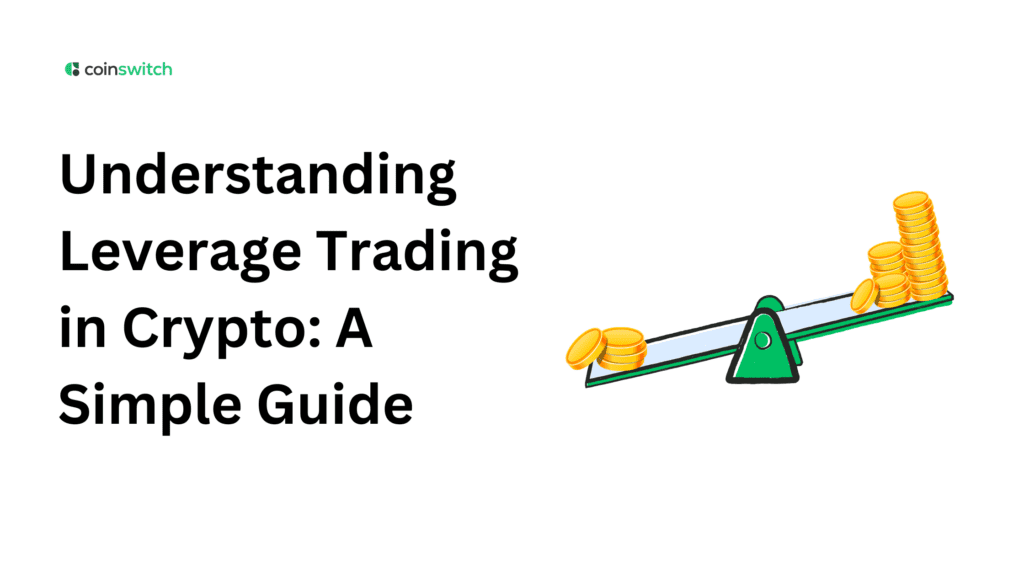Every crypto trader knows that moment when you spot a breakout forming, conviction builds, but your capital feels small. That’s when leverage trading steps in, helping you stretch every rupee by enabling traders to take larger positions and amplify profits. On CoinSwitch, India’s largest crypto app, this becomes seamless through CoinSwitch’s leverage available on their PRO platform, which lets you trade positions up to 100x larger than your deposit.
Think of it as a financial accelerator: you borrow funds to multiply potential profits, but losses grow too. You’re still in control, but the speed rises sharply. That’s why understanding margin, liquidation, and position sizing is essential before diving in. The best part? CoinSwitch lays it all out clearly; your margin, liquidation price, and risk metrics are visible before you hit confirm, providing traders the confidence to use leverage with clarity instead of guesswork.
Get to Know Futures Margin
Before touching leverage, you need to meet its backbone, the futures margin. In crypto, a futures contract is an agreement to buy or sell an asset at a future price. With this feature, you can trade based on where the price moves next, without even owning Bitcoin or Ethereum directly.
Here’s where it gets interesting. You don’t have to put down the full trade value. You just commit a small fraction, called margin. That’s your deposit, your ticket to control a much larger position. On CoinSwitch, this margin unlocks the ability to trade multiple times your capital, whether you’re betting on prices going up (long) or down (short).
Let’s understand it better with an example. Suppose you have ₹10,000. With 10× leverage, you can open a ₹1,00,000 position. With 25×, that same ₹10,000 gives control over ₹2,50,000. The idea is simple: less money in, more exposure out. But with higher leverage, even small price changes matter. A 1% drop at 25× leverage hits your margin like a 25% fall.
Read More: What are Hedging Contracts: An Explainer
Initial Margin
When you decide to open a leveraged position, the initial margin is your starting stake, the minimum you must deposit to enter the trade. It’s like saying, “I’m serious about this position.”
Using CoinSwitch leverage, this figure changes based on how much risk you are willing to take. Choose a higher leverage, and the required margin shrinks. For example, to open a ₹1,00,000 Bitcoin position at 25× leverage, you’ll deposit ₹4,000. At 10×, you’ll need ₹10,000. It sounds appealing, small entry, big play, but the thinner your margin, the closer you stand to liquidation.
That’s the trade-off professionals understand well. Many traders keep extra funds in their accounts, topping up when volatility spikes. That cushion gives breathing room when the market whipsaws.
CoinSwitch makes this clear visually. The moment you input your leverage, it displays your unrealised profit/loss, liquidation price, and risk of liquidation.
Maintenance Margin
Opening a position is the easy part. Keeping it alive, that’s where maintenance margin comes in. It’s the minimum balance you must hold to stop your trade from being automatically liquidated. In other words, it is the minimum amount a trader must maintain in a margin account to keep a leveraged position open.
Here’s how it plays out. Imagine you’ve gone long on Bitcoin at ₹1 cr with 20× leverage. The market dips to ₹98 lakh. Your equity (margin + unrealized profit/loss) starts shrinking. If it falls below the maintenance margin level, your trading platform steps in and closes your trade. This prevents you from losing more than your deposit.
It may feel brutal, but it’s a safeguard. The exchange doesn’t want traders sinking into negative balances. It’s risk management.
Maintenance margin varies depending on leverage level and position size. The higher your leverage, the smaller your safety net. That’s why serious traders monitor this metric like hawks. On CoinSwitch, your dashboard shows the risk of liquidation. If it is 75%, it’s a warning. Add collateral, cut exposure, or the system will close the trade for you.
The trick is staying ahead of that line. Most professionals keep a small buffer above maintenance margin, giving them room to survive normal price swings. In leverage trading, running too close to liquidation is like driving on fumes, thrilling for a second, and dangerous in the long run.
Read More: What is Momentum Trading?
Trading Crypto With Leverage
Now that the groundwork is set, let’s talk about the real action: trading crypto with leverage. This is where everything clicks.
When you use leverage on CoinSwitch, you’re essentially borrowing from the platform to amplify your exposure. A 10× leverage means you’re controlling 10 times your actual deposit. That power can be exhilarating when used wisely. But it’s also what makes leverage the sharpest tool in crypto trading, one that rewards precision, punishes overconfidence.
Let’s run through a quick example. You open a long position on Ethereum worth ₹1,00,000 with ₹10,000 as margin (10× leverage). If ETH climbs 5%, you gain ₹5,000, a 50% return on your margin. But if ETH falls 5%, you lose ₹5,000. Double-edged, clean, and instant.
Professional traders use leverage differently. They don’t max out exposure on every trade. They hedge. They size positions based on volatility. Some even use low leverage, like 3× or 5×, to fine-tune entries. The point isn’t to gamble, it’s to optimize capital efficiency.
CoinSwitch simplifies this experience. The interface shows liquidation prices upfront, lets you adjust margin, and even displays estimated returns before execution. You know your risk before the market tests it.
Leverage is thrilling because it compresses time. Gains that might take a week can appear in an hour. But so can losses. The skill lies in balance and managing small moves with intent.
If you treat leverage like a magnifying glass instead of a casino ticket, it becomes a powerful ally.
Conclusion
Leverage trading is the heartbeat of modern crypto markets, fast, flexible, and filled with opportunity. It gives traders the power to participate in big moves without tying up massive capital. Yet it demands respect.
Platforms like CoinSwitch bring discipline to this high-octane world. From transparent margin data to real-time liquidation alerts, every element of CoinSwitch leverage is built around clarity. You always know how much you’re risking, how close you are to liquidation, and what your next move should be.
The secret is in managing exposure. Smart traders find the right leverage number for the moment instead of chasing the big ones. They treat margin like oxygen, too little, and the trade dies; too much, and returns thin out.
FAQs
1. How does leverage trading work in crypto?
Leverage trading allows you to borrow money from the exchange to trade positions larger than your balance. On CoinSwitch, this means depositing a margin, a fraction of your total trade value, while the platform provides the rest. Profit or loss is calculated on the full position size, which makes both moves amplified.
2. What does 10× leverage mean in crypto?
10× leverage gives you ten times more exposure than your actual deposit. A ₹10,000 margin controls a ₹1,00,000 position. A 1% market move now equals a 10% swing in your capital. It’s powerful, quick, and demands solid risk control.
3. What does 100× leverage mean in crypto?
100× leverage means a single rupee acts like a hundred. With ₹1,000, you control ₹1,00,000 worth of crypto. A tiny 1% price change can double or erase your margin instantly. CoinSwitch keeps leverage caps at safer levels to prevent such instant wipeouts, making the platform more secure for retail traders.
4. How much is $100 with 10× leverage?
$100 with 10× leverage gives you a $1,000 position. Every 1% price move equals a 10% gain or loss relative to your margin. That’s why managing liquidation and maintaining healthy margin ratios are essential when using CoinSwitch leverage.








